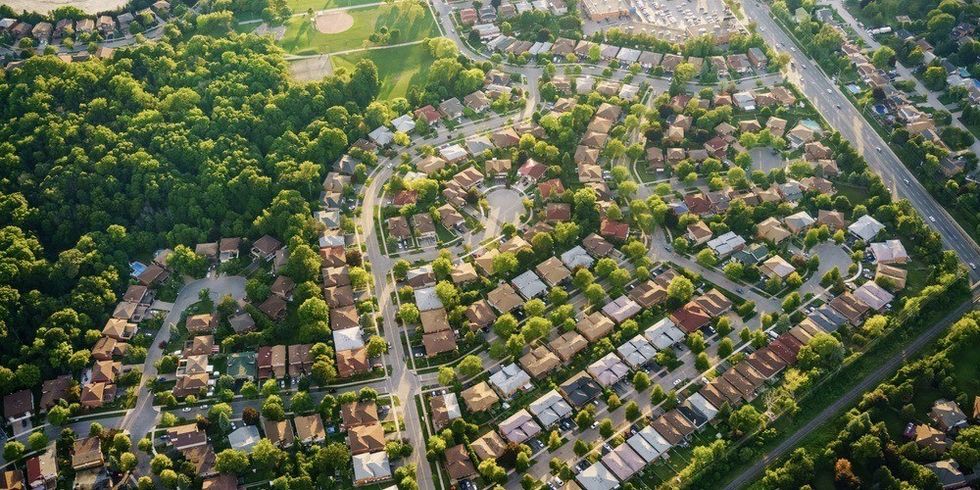Back in the early days of COVID-19, experts warned of a potentially catastrophic mortgage deferral cliff in Canada that would take place once postponed payments resumed in the fall. In fact, as early as mid-May, Canadian Mortgage and Housing Corporation (CMHC) CEO Evan Siddall said the housing corporation was forecasting between a 9 and 18% drop in average house prices over the next 12 months as a result of the deferrals.
But that cliff hasn't materialized. And it may never.
While experts like Bob Dugan, Chief Economist at the CMHC, caution that “we’re not necessarily out of the woods yet,” so far, Canada has yet to see any evidence of this looming mortgage deferral cliff.
Quite the opposite. Rather than residential streets lined with foreclosure signs, real estate sales are booming in Toronto and other parts of the country. Average home prices have only increased since the start of the pandemic -- setting records for sales as well --with industry insiders predicting an even more competitive year in 2021.
READ: Mortgage Deferral Data Can’t Paint Clear Picture of Future: Bank of Canada
When CMHC forecast that drop in average home costs between 9 and 18%, Siddall also announced that, through the re-launch of the Insured Mortgage Purchase Program -- a coordinated effort with both the Bank of Canada and the Department of Finance -- the CMHC stood ready and able to purchase up to $150 billion of insured mortgages.
The COVID-inspired initiative was in combination with CMHC’s efforts to work alongside private mortgage insurers to provide Canadians with the option of a temporary deferral of monthly mortgage payments for up to six months. Siddall predicted that all the borrowing would lead to historic levels of household debt. “The combination of higher mortgage debt, declining house prices, and increased unemployment is cause for concern for Canada’s longer-term financial stability,” he said at the time.
Dugan confirms his colleague’s sentiment. “Initially, we had this terrible downturn in the economy, with over three million jobs lost,” said Dugan. “There was a fair bit of take-up of the deferral program when it was in place, but part of the worry was that Canadian households were already fairly indebted going into this downturn; debt-to-income ratios were always very high. While the deferral can get you through a hard time during the downturn, you have to eventually resume making those payments. Plus, there’s the missed principal on interest on those payments.”
Subsequently, the fear was that countless unemployed Canadians would not be able to resume making mortgage payments once the initiative expired -- and the potential consequences looked bleak. Thus, the CMHC predicted the aforementioned unprecedented 12-month drop in home prices between the end of 2020 and the beginning of 2021.

“Originally, as the pandemic hit, I think it was more of a worry,” says Dugan. “There are a number of mitigating factors that changed my view about the severity of the potential cliff as time went on.”
For one, both he and Toronto mortgage broker Jerome Trail, owner of The Mortgage Trail, point to the mortgage deferring demographic.
“There are many instances of people losing it all during this time, however, the mortgage deferral cliff has not happened – at least not yet,” says Trail. “This could be because the demographic most impacted by income loss during the pandemic are not homeowners. They are, mostly, lower wage earners and could not afford a home in the first place and are likely renting.”
The sad reality is that the relentless COVID-19 pandemic hasn't financially impacted all Canadians equally.
“When we looked at COVID-related job losses, it became evident that they were focused in lower paying jobs in things like accommodation and the food service industries,” says Dugan. “These were significantly more affected than the higher paying professional jobs that were more adaptable to remote working, for example. So, a lot of these job losses were predominantly at income levels that didn’t impact homeowners.”
READ: Don’t Call it a Comeback: Toronto’s Condo Market is Already Heating Up Again
The bottom line is that those in home-owning bracket of income ranges had a much easier time than many people in the lower income brackets who lost their jobs (and are perhaps still unemployed). That’s not to say, however, that they did it entirely on their own.
“The government relief programs have been so broad and generous, that they have helped a lot of people avoid catastrophic financial hardship,” says Trail. Dugan similarly points to the role of COVID-inspired government programs that offered income support to households. “Wage subsidy programs that helped companies keep people on payrolls who may have otherwise lost their jobs, as well as things like the CERB program, for example, had a big impact,” says Dugan.
In the second quarter of 2020, the economy preformed at its worst. During that time, compensation of employees dropped by a record 8.7%. “Usually, that would represent a huge chunk of disposable household income,” says Dugan. “But despite that drop, disposable income actually shot up by 11.1% in that quarter. A lot of that discrepancy between the drop in employment income and the rise in disposable income had to do with the government income support transfers to households.”
Rather than meeting dire financial straits, it turns out many Canadians were actually saving their precious pennies. “The household saving rate -- the amount that’s left over after all expenses -- was 2% or lower in Canada before the downturn. It shot up to 27.5% in the second quarter,” says Dugan. “So, you have this pandemic going on with massive job losses, but incomes actually shot up and people saved a lot of that income; there was nowhere to spend that money due to lockdowns. A the end of the day, households built up a significant amount of savings.”
By the third quarter of 2020, the economy was beginning to recover. “Disposable income did come down a little bit in the third quarter, but it was decreasing from historically high levels,” says Dugan. “And the savings rate was still 14.6% in this time period.” The increase in household savings, says Dugan, will be a major mitigating factor moving forward.
Supporting Dugan’s arguments, figures released last month from the Canadian Bankers Association revealed that most Canadian borrowers had indeed resumed their regular mortgage payments. As real estate commentator Ben Rabidoux recently highlighted in a tweet, there were just 45,000 mortgages deferred at the end of November (a far cry from over 600,000 in July); "Had all of those houses hypothetically been foreclosed/listed for sale that month, there would still have been fewer homes for sale across the country than in Nov 2019," he wrote.
What it comes down to is that we can thank things like a bounce-back in employment, the income support programs, and high savings rates from preventing a devastating mortgage deferral cliff -- at least, for now, we can.
“I think there are still risks -- I don’t want to suggest that there’s nothing to worry about, as Canadian households still carry a high level of debt -- but it’s not as much of an issue as we’d thought at present time,” says Dugan.
READ: Led By Single-Family Homes, Average GTA Home Prices Smashed Records in 2020
The impossible-to-ignore reality is that real estate is booming when it comes to single-family homes. But just as glaringly obvious is the reality that the country is now in the grips of a devastating second wave of the virus that's hitting even harder than the first. Frankly, anything seems possible on the economy front these days, with the threat of another downturn all too real.
This, coupled with the fact that it takes three months for a mortgage to go into default, may lead some to claim it’s simply too early to tell whether we'll see a mortgage deferral-inspired dip. Perhaps we'll have a clearer picture once the ground thaws in the spring.
But nearly a year into the pandemic, the cliff seems to have been cut down to little more than the possibility of a gentle rise.






















